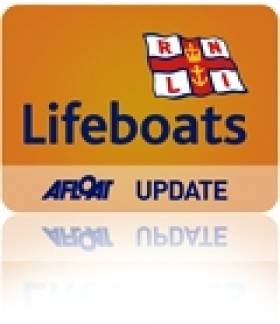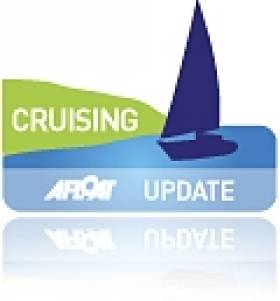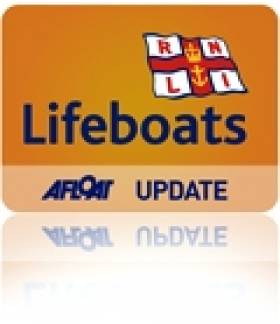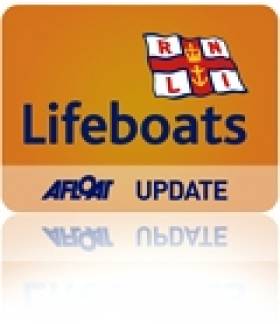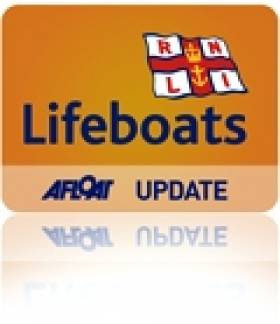Displaying items by tag: RNLI
Jimmy Tyrrell – An Arklow Maritime Legend
#arklow legend – We are fortunate in this country to have people who are dedicated to the marine sphere and who give freely and willingly of their time and efforts in pursuit of their belief that maritime matters really should matter to the national community.
Jimmy Tyrell from Arklow is such a man. I have known and respected him through his work for the lifeboats for many years.
The RNLI has a proud history of over 190 years and the port of Arklow in County Wicklow, a town founded by the Vikings in the 9th century, lays claim to being the first lifeboat station established in Ireland, back in 1826. Jimmy Tyrrell has led lifeboat operations there for 46 years. His family is legendary in maritime matters.
Twenty-seven years ago Jimmy made a decision. The RNLI named its different classes of boat designs after rivers, but had never used the name of an Irish river. Jimmy was determined to change that and being a determined man, he achieved his goal. So when the new Shannon Class was born, the most modern vessel in the RNLI fleet and the first into Ireland arrived at the Lough Swilly Station at Buncrana in County Donegal, Jimmy was there to see it.
It was a great day for Jimmy, well-deserved and he describes his feeling as he saw the boat arrive on this edition of THIS ISLAND NATION.
When Jimmy retired from RNLI duties in Arklow another member of that great maritime family stood up to take over from him and continue the family association, John Tyrrell, who is now Lifeboat Operations Manager there.
The new Shannon lifeboat at Lough Swilly cost €2.4m and was designed by a Derry man who works for the RNLI at its Poole headquarters. It uses twin waterjets instead of propellers, giving it more manoeuvrability and the ability to operate in shallow waters. The man who designed it is Peter Eyre and he was once saved by the lifeboat service when he got into difficulty on the water, the story of which he tells also on the current edition of THIS ISLAND NATION.
When the RNLI describes a boat as "all-weather..." they mean it, the service always responds to calls for help, even in the worst of sea conditions, so the crews deserve the best boats. The Shannon has a top speed of 25 knots, a range of 250 nautical miles and a unique hull to minimise slamming of the boat in heavy seas, with shock-absorbing seats to protect the crew from impact when powering through the waves. The Lough Swilly lifeboat has been largely funded through a legacy from Derek Jim Bullivant of Bewdley, Worcestershire, in the UK who died in September of 2011.and is named Derek Bullivant. Coxswain, Mark Bennett, commands it and was welcomed by a huge crowd when he and his crew brought the boat from Poole to Buncrana. He tells us how it was an emotional day for him.
BASS BAN
This edition of Ireland's niche maritime programme also has an interesting story about supermarket advertising which can mislead purchasers into thinking they are buying Irish bass when it is illegal to catch them for commercial purposes in Irish waters, where such fishing is banned. So why are the public misled by advertising which says "Irish produced bass" when they come from fish farms abroad?
David Stanton, the Fine Gael TD for Cork East interested – and somewhat pleasantly surprised me – by making an issue of the lack of Government and State attention to the marine sphere. It's not often, I put to him, that a politician is heard to draw attention to maritime matters. He has a good point -that there is no single, central point in the State system, no 'one-stop-shop,' where all maritime enquiries can be dealt with, so anyone proposing a project can be sent from one section of the State services to another so many times they could meet themselves coming back. He is worth listening to and I'll be looking forward to hearing how the self-imposed mission he has declared, to highlight maritime affairs at Government level, gets on.
The island communities join the programme with a regular report, in which we hear why €60,000 a year, not a huge sum of money, is vital to education on the islands.
A lot then, about maritime matters which you can hear THIS ISLAND NATION by clicking on the programme icon above
Your comments are welcome below.
Kilrush RNLI Lifeboat In Multi-Agency Search Operation
#lifeboat – Lifeboat crew launched early this morning to take part in a multi agency search and rescue operation involving Kilrush and Fenit RNLI, Coast Guard rescue teams from Kilkee and Doolin.
At 3.29am Shannon Coast guard tasked Kilrush RNLI volunteer lifeboat crew to investigate a report of four persons in the water in the Poulnasherry Bay area of the Shannon Estuary.
Kilrush lifeboat crew were met by members of the public on the scene who had successfully recovered three persons safely from the water. The casualties were transferred by ambulance to Limerick Regional Hospital. Kilrush RNLI, Kilkee Coast Guard and the Shannon based Coast Guard helicopter undertook a large-scale search of the area to locate a fourth missing person.
The search operation continued through the night with the addition of Fenit RNLI lifeboat, Doolin Coast Guard, Irish Customs Vessel, Ballybunnion Rescue Services, SFPC Pilot Boat as well as an extensive shore search team from all agencies as well as navy diving units.
A person was recovered from the water at 10.42am following an extensive search.
Commenting on the callout, Pauline Dunleavy, Kilrush RNLI Lifeboat Operations Manager said: 'This was one of the largest search and rescue operation in the Shannon Estuary for a number of years. I would like to commend the quick response from all agencies especially the members of the public that assisted. On behalf of everyone at Kilrush RNLI Lifeboat Station, I wish to express our sincere condolences to the family and friends of the man who sadly did not survive.
Lough Derg Lifeboat Takes Boat & Jet Ski In Tow
#rnli – While out on exercise last night, Lough Derg RNLI Lifeboat came to the assistance of five people whose boat had suffered engine failure, at the south western end of Lough Derg.
At 8.30pm the Lifeboat observed a boat close to shore at Two Mile Gate, flash a distress signal with a torch. Upon investigation the lifeboat found five people, four adults and one child on board a 20ft boat that had suffered engine failure. They had contacted two friends for assistance, but having attempted to tow them, the battery on their jet ski failed.
The lifeboat crew, with Helm Eleanor Hooker, Robbie Garland and Owen Cavanagh on board, contacted Valencia Coast Guard to make them aware of the situation and to let them know that they were going to assist. The wind was a cold northerly wind, Force 2-3. Visibility was fair with failing light.
The lifeboat secured the jet ski and took the boat with her passengers and an RNLI crew member on board, under tow to their mooring at Killaloe. Once the boat was safely tied alongside, the lifeboat took the two jet skiers plus their vessel upriver and under the bridge at Killaloe to their launching slip, where they could recover their jet sk
The Lifeboat returned to Station and was ready for service again at 10.33pm.
Lifeboat Operations Manager, Liam Maloney advises all boat users to 'fully service your boats and engines before going afloat'. He added 'if in difficulty on the lake, called 999 or 112, or use Channel 16 on VHF and ask for marine rescue'.
Coastguard Helicopter Rescues Three After Fishing Boat Sinks
#rnli – Wickow RNLI lifeboat launched this afternoon to a stricken fishing boat that sank off the east coast. Latest news reports from the area say three fishermen were rescued by Coastguard helicopter from a liferaft, 12km off the coast after a lobster boat boat sank around 2.15pm. The three are being treated for hypothermia in Tallaght Hospital, according to RTE news.
#luggerroundireland – Two brothers will begin a circumnavigation of Ireland in an 18ft–Drascombe Lugger dinghy, Lughnasa this June bank holiday. Fergus and Nathaniel Ogden will set off on the c. 1000 mile voyage from Baltimore, West Cork. Hoping to achieve between 15-30 miles a day, they will live on-board the boat, calling into various stopovers along the coast - beginning with Crookhaven.
At an average speed of 3-4 knots, this won't be the fastest circumnavigation of Ireland ever achieved, but the Drascombe's rugged build quality makes it a fine boat for the job, and will be the first time an open Lugger has attempted to sail around Ireland.
They anticipate the voyage to take about a month, though the Atlantic conditions off the West Coast will play an important role in their journey time.
Aged 16 and 22, this will be the brother's longest voyage together. Personal space will take on a new meaning for the lads with cramped living on-board, and tensions are sure to run high as the 18 feet of Drascombe becomes home. Balmy days spent rolling on the long and gentle swells in the baking Irish sun will help reduce some of this pressure, however and provide plenty of opportunities for photo and video footage of the voyage. With none of the luxuries found inside a cabin, Facebook and website updates will be done as often as possible from their overnight stops.
The Ogdens are undertaking this challenge to raise funds for the RNLI, who are officially supporting their adventure.
By doing this they would like to help raise awareness for safety at sea as the number of lifeboat callouts for leisure craft has been increasing in recent years.
To keep up with the Ogden brother's progress visit their website where you can make a donation to the RNLI and follow their blog.

onboard the Lughnasa
ROUGH ROUTE PLAN, NOT CONSIDERING ALL CONTINGENCIES. LEAVING BALTIMORE AND HEADING WEST
Crookhaven
Castletown Bearhaven
Ballycrovane Harbour
Derrynane Harbour
Knightstown, Valentia
Dingle
Brandon
Kilrush/Carrigholt
Inishmore
+ /- Galway, Roundstone, Clifden, Cleggan
Inishbofin
Clare Island
Belmullet
Kilcummin
Rosebeg
Tory
+/- Lough Swilly Stopover
Portballintrae
Rathlin / Ballycastle
Donaghdee
Carlingford
Ardglass
Howth/Dun Laoghaire
Wicklow
Wexford
Kilmore Quay
Dungarvan
+/- Youghal
Cork Harbour - Crosshaven
Kinsale
Clonakilty
Glandore / Castletownshend
Baltimore
'Duck Race' For Helvick Head RNLI Hailed A Success
#RNLI - The Duck Race in aid of the Helvick Head RNLI lifeboat station on Saturday 11 April 11th was a "spectacular success", according to race co-ordinator RoseAnn Foley.
As part of the Cois Cé celebrations during West Waterford Festival of Food, the 600 little yellow ducks entered the water from Devonshire Bridge in Dungarvan at 1.15pm with a lively commentary from Jenny Beresford and Sean Breathnach as they floated down Davitt’s Quay.
First prize in the Duck Race went to RNLI crew Liam Harty. Second was a photo finish between Séamus Kiersey from Ardmore and Tomás de Faoite ón Rinn, while third went to Tom Considine from Dungarvan and fourth went to Catherine Downey also from An Rinn.
Later, all the ducks were collected from the mud and were washed and put into storage until their next race.
And they weren't the only attraction on the day, with a free lifejacket clinic and sea safety check conducted by Austin Flynn also proving popular.
"We are very grateful to the public, Dungarvan Harbour Sailing Club, the kayakers, SGC and all our sponsors, West Waterford Festival of Food and the media for their enormous support," said Foley.
Bundoran Lifeboat Rescues Teen After Jet Ski Capsize
#RNLI - Bundoran RNLI rescued a teenager who fell from a capsized jet ski on Thursday afternoon (9 April).
The volunteer crew was requested to launch their inshore lifeboat by Malin Head Coast Guard at 1.24pm following a report that a jet ski had capsized a short distance from Bundoran Pier.
The lifeboat, helmed by Daimon Fergus and with crew members James Cassidy and Elliot Kearns on board, launched and made its way to the scene just a couple of hundred yards from the shore. Weather conditions at the time were described as good with the sun shining and the sea flat calm.
On arrival, the crew observed two males, one of whom had managed to get back on to the jet ski and a second who was still in the water.
The lifeboat crew pulled the teenager from the water and brought him back to shore where he was treated for hypothermia and the effects of having swallowed some sea water. He was subsequently transferred to Sligo General Hospital via ambulance as a precautionary measure.
"Thankfully, the lifeboat crew were able to assist this afternoon and bring this young man to safety," said Bundoran RNLI lifeboat operations manager Tony McGowan after the callout.
McGowan also encouraged anyone taking to the water "to enjoy themselves but be mindful that while the sun is shining and the weather is warm, sea temperatures are still very cold and it is important to dress appropriately bearing that in mind."
Bundoran's lifeboat crew were tasked again on Friday night (10 April) to reports of a red flare spotted over Rossnowlagh.
Following a call to Malin Head Coast Guard, the crew were paged just after 9pm and launched a short time later under cover of darkness, arriving at Rossnowlagh just before 9.30pm to commence a search of the area near Smugglers Creek. They were also joined by the Sligo-based Irish Coast Guard helicopter.
The search continued for approximately one hour before both crews were stood down and returned to base having found nothing.
Speaking on their return to the lifeboat station, volunteer helm Elliot Kearns said: "We would class this a false alarm with good intent and the member of the public who made the call was exactly right to call the coastguard. We would always rather be called to something that somebody was unsure about rather than a life be lost."
However, Kearns also urged anyone setting off Chinese lantern or lighting fires near the coast "to call the coastguard in advance to advise them. Of course if you see anyone in trouble at the coast please dial 999 or 112 immediately."
The callout was the third in a week for the Bundoran station, beginning with the rescue of a surfer in difficulty off Tullan Strand on Monday 6 April.
#RNLI - Arranmore RNLI saved two fishermen on Wednesday afternoon (8 April) after their 10m boat capsized off the Donegal coast.
A member of the public who was watching the fishing vessel from the shoreline raised the alarm at 2.50pm after he saw the boat capsize two miles south of Arranmore.
Arranmore RNLI’s boarding boat, which was already at sea with coxswain Anton Kavanagh and mechanic Philip McCauley on board, made its way to the scene.
Weather conditions at the time were described as blowing a gentle Force 2 to 3 wind but there was a heavy ground swell of three to four metres.
During their short passage, the volunteer lifeboat crew spotted and followed a track of fuel, and once on scene observed the wreckage of the stricken vessel. They then observed the two fishermen in the water approximately 300 yards from where the boat had capsized.
Both men were very cold when they were pulled from the sea and brought onboard Arranmore RNLI’s boat.
They were brought to Aphort Harbour, where they were made comfortable before being airlifted by the Irish Coast Guard’s Rescue 118 helicopter from Sligo and transferred to Letterkenny General Hospital.
Speaking following the callout, Anton Kavanagh said: "Both men are very lucky to be alive today and full credit must go to the member of the public who saw the boat capsize and raised the alarm, because the fishermen were not due back to shore for a couple of hours.
"We were delighted to be able to help and are glad that both men are safe and well."
Courtmacsherry RNLI Respond To Third Call-Out In 12 hours
#courtmacsherryRNLI – For many it was the end of the working week, but for members of the Courtmacsherry RNLI All weather Lifeboat Crew, yesterday evening was only the commencement of a very busy period of activity at sea, as it has now responded successfully to three rescues off our shores writes Vincent O' Donovan.
The All weather Trent Class RNLI Lifeboat was called out again this afternoon Sat at 3.50pm to respond to a Mayday call from a 55ft Fishing vessel that encountered difficulities just 2 miles south of the Old Head Of Kinsale in West Cork. In fresh winds blowing Force 5, with a two meter swell, the Lifeboat was away within minutes and located the casuality at 4.25pm and immediately secured a tow line. It has now brought the vessel under its control and is proceeding to tow the fishing boat, with six crew on board back to Kinsale harbour. As conditions at sea this evening are poor, its estimated time of arrival into Kinsale is 6.30pm.
Today's callout follows last evening rescue of a 60ft fishing vessel two Miles off The Seven Heads coastline which had got into difficulties at 5.40pm with 5 crew on board.As that Fishing vessel was safely berthed at Courtmacsherry Pier last evening at 8.45pm, an emergency call was received from Valentia Coastguard, that a large dog had fallen off the high cliffs at File Na Mho, near Broadstrand in Courtmacsherry Bay and that the owner who had tried to climb down the cliff to retrieve it, had failed and was in danger himself. The owner alerted the rescue Services through a 999 call and immediately, the Courtmacsherry Lifeboat responded. Within minutes at 8.50pm, the Lifeboat arrived at the Base of the cliffs and using its powereful engines and spotlights, located the stricken dog on the rocky waters edge.
Using its inflatable punt two members of the Lifeboat crew in special RNLI Lifeboat wetsuits suceeded in securing the Large Rhodesian Ridgeback and brought it to the safety of the Lifeboat, while the powerful Lifeboat Searchlights guided its owner to safety at the cliff top.
Twenty minutes later the owner and the large dog were both reunited in safety at the Lifeboat Station.
Dublin Bay Sailing Partnership Based on Artistic Endeavour
#iris – It has been said that keeping a boat-owning partnership intact is much more difficult than maintaining a marriage in a healthy state. Thus for most of us with the boat-owning vocation, sole ownership is the only way to go. But for others, in order to defray costs, increase boat size, and maybe leave more personal time free to pursue other interests, the ambitions can best be realised through one of a wide variety of partnerships and syndicates.
These can go through an extensive range, starting at one extreme with what amounts to time-sharing, with the large number of owners meeting (if they meet at all) only once a year for a sort of Annual General Meeting. Other possible setups can mutate through various arrangements where there is considerable overlap between the boat uses by the different owners, right through to the other extreme of total partnership where all owners sail together as often as is possible.
In some cases, the additional social glue of special shared interests is needed to give the partnership that essential extra vitality. There's nothing new in this. W M Nixon takes a look back a hundred years and more to a boat-owning group whose shared interest in art kept a 60ft ketch on a regular cruising programme around Dublin Bay and the nearby coastlines.
The 60ft gaff ketch Iris had a chequered career. She started life at the peak of the Victorian era in the 19th Century as a naval pinnace serving Dublin Bay, and she was presumably driven by steam. At the time, Dun Laoghaire – then known as Kingstown – was becoming the height of fashion as a naval port of call in the summer, made even more so by its convenient access to the centres of power in Dublin, and its strategically useful direct rail connection – pierhead to pierhead – to the main Royal Navy base in Ireland at Cobh on Cork Harbour.
However, as Kingstown had initially been planned solely as a harbour of refuge – an asylum harbor - for ships in distress in onshore gales, with the actual spur to its construction (starting in 1817) being the wrecking of a British troopship with huge loss of life at Seapoint on the south shore of Dublin Bay, the plans had included no provision for convenient alongside berthing for ships.
Indeed, you get the impression that the original underlying thinking was that there should be as little social contact as possible between ships sheltering in the new harbour and any inhabitants of its nearby undeveloped shore. But the rapid if somewhat chaotic growth of the makings of a new harbourside town, plus the advent of more rapid access from Dublin with the coming of the railway in 1834, soon meant that the top brass expected to be able to get off and on their ships in the harbour in style and comfort, and their Lordships of the Admiralty did not stint in providing large pinnaces for them to do so. When these pinnaces were replaced in due course by even more luxurious vessels, those shrewd amateur sailors who could visualise the older boats' potential as re-cycled government surplus found themselves looking at a bargain.
The Iris was originally built with lifeboat-style construction of double-diagonal hardwood planking, which was quite advanced technology for the time. For the can-do boatbuilders of the late 19th Century, converting such totally purpose-built craft into some sort of a yacht was all part of a day's work. Another similarly-built if smaller and different-shaped vessel, Erskine Childers' Vixen on which the Dulcibella of The Riddle of the Sands fame was based, was formerly an RNLI lifeboat with the standard lifeboat canoe stern. She was made more yacht-like by the addition of a staging aft to compensate for the absence of deck space just where you most need it, while underneath this new permanent staging, additional supporting planking was faired into the hull and – hey presto – you've a yacht-like counter stern.
Vixen also had a massive centre-plate complete with its huge casing, and carried more than three tons of internal iron ballast, all of which left little enough space for living aboard during the long and often rough cruise through the Friesian Islands which provided much of the on-the-ground material – and we can mean that in every sense – on which The Riddle was based.

Erskine Childers' Vixen (on which "Dulcibella of The Riddle" was based) in one of his last seasons of ownership in 1899. At first glance, she looks like a typical old-style cruising cutter of her era. But somewhere in there is a classic canoe-sterned RNLI lifeboat hull to which an afterdeck on a counter stern have been fitted as an add-on.
That cruise was in 1897, and shortly after it was completed, Childers went off to serve in the Boer War. This experience left him with doubts about the validity of the British Imperial mission, but equally left him in no doubt that on active service, there were no medals for enduring unnecessary discomfort. So by the time The Riddle of the Sands was published in 1903, Vixen was sold and he'd become a partner in a much more comfortable cruising boat, the yawl Sunbeam, which in turn was followed in 1905 by his very comfortable dreamship Asgard
Meanwhile, with the Iris a fifteen or so years earlier in Dublin, the conversion to a comfortable sailing cruiser was a more straightforward affair, as she'd a more versatile hull shape with a broad stern in the first place, and her new owner was one George Prescott, an innovator bordering on genius. He was an optical and scientific instrument maker, an electrical engineer and inventor, and a state-of-the-art clockmaker.
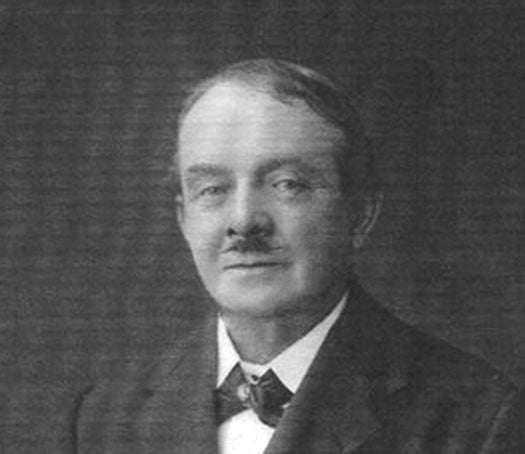
Man of many parts – the polymath George Prescott. Organising the Graphic Cruising Club and running its club-ship Iris was only one of his many interests. He led a long and extraordinarily interesting and varied life, and was nearly a hundred years old at the time of his death in 1942. Courtesy Cormac Lowth
But that was only one part of his life, for he had many friends among Dublin artists, particularly those interested in maritime topics, and he soon found himself to be the secretary of the Graphic Cruisers Club for sailing painters and sketchers, with the Iris becoming the base of their waterborne creative and scientific expeditions on the coast of the greater Dublin area.
She was ideal for this. She'd been converted for sailing with an orthodox gaff ketch rig, while her roomy hull was internally re-configured to have a galley with a large stove right aft, a huge saloon immediately forward of the galley to be both the clubroom and dining room, and sleeping quarters port and starboard in pilot cutter style forward of that.
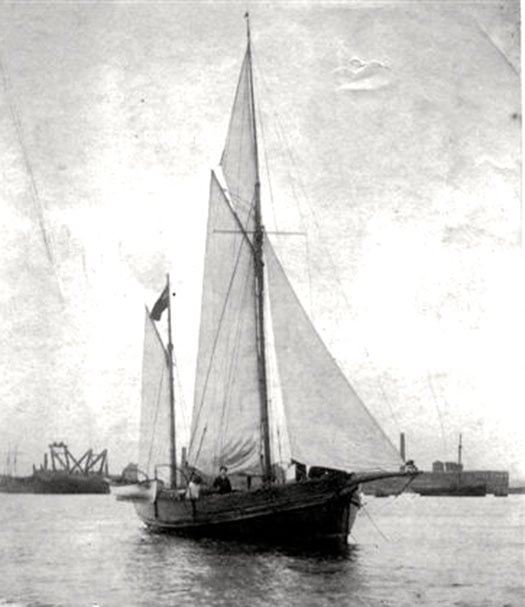
Quite a transformation for a former steam-powered naval pinnace. The 60ft ketch Irish in her heyday as the club ship of the Graphic Cruisers Club in the 1890s. She is at her home anchorage off Ringsend, while across the Liffey a couple of Ringsend trawlers are lying in the roadstead known as Halpin's Pool, where the Alexandra Basin is now located. Photo courtesy Cormac Lowth

Accommodation profile of the Iris in her days as the floating HQ of the Graphic Cruisers Club – this sketch by Alexander William first appeared in The Yachtsman magazine in 1894.
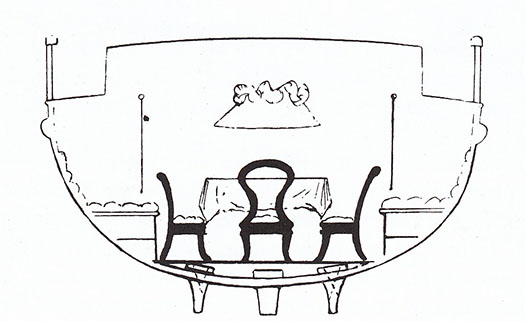
Hull section of the Iris at the saloon, showing the bilge keels which enabled her to dry out comfortably in some some little-known tidal anchorages in the Greater Dublin area.
But underneath the hull, the temptation had been resisted to add a deep keel, and instead the Iris was fitted with substantial bilge keels at the same depth as the shallow keel itself, such that in all she drew only about 3ft 6ins, and would comfortably dry out in a snug berth anywhere that her artistic crew felt they might find subjects worthy of their attention.
Thus she might overnight serenely on the beach at Ireland's Eye or far up the estuary at Rogerstown, and if the Graphic Cruisers Club attention was turned towards County Wicklow, she could comfortably take the ground in Bray or in other little ports inaccessible to orthodox cruising yachts. Yet the claim was that despite the odd arrangements beneath the waterline, she handled remarkably well on all points of sailing, and certainly as she no longer had any sort of engine, she must have sailed neatly enough to get out of some of the confined berths into which her eccentric crew enjoyed putting her.
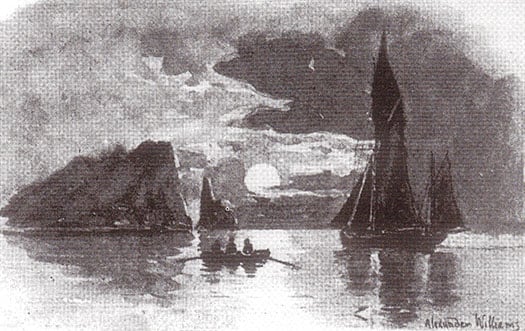
The Iris in gentle cruising mode off Ireland's Eye as the moon rises – this was sketched by Alexander Williams for The Yachtsman in 1894.
George Prescott seems to have been happy to claim that Iris was a club-owned yacht, but in truth most of his shipmates were impecunious artists of varying talent, so it was his generosity and understated business ability which would have kept the partnership together.
However, it really did seem to function as a partnership, for after the Iris project had been up and running for nearly a decade, he turned his attention in 1896 to building an unusual house on the waterfront on the Pigeonhouse Road in Ringsend, which he happily acknowledged to be the clubhouse of the Graphic Cruisers Club even if he lived in it himself.
Called Sandefjord for some reason which is still unexplained, it looked not unlike a smaller sister of the Coastguard Station next door, complete with a lookout tower. And it's distinctly nautical within, as much of the interior includes fine panelling which came from the wrecked Finnish sailing ship Palme, with the stairs being provided by the old ship's main companionway.
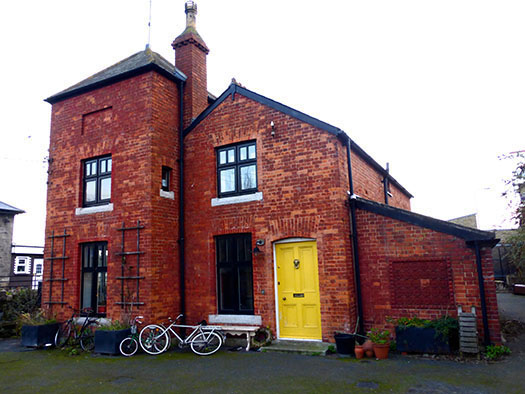
The house called Sandefjord near Poolbeg Y & BC as it is in 2015. When built by George Prescott in 1896, it faced across the Pigeonhouse Road directly onto the waterfront, and overlooked the summer anchorage of the Iris. Photo: W M Nixon
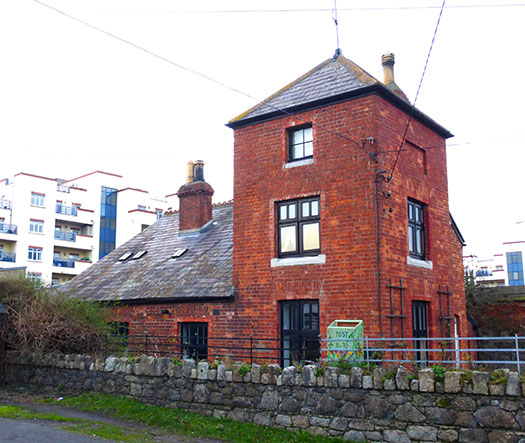
The design style of the Graphic Cruisers Club shore HQ at Sandefjord reflected the lookout tower of the old Coastguard Station next door. Photo: W M Nixon
The house has been restored to become a family home in recent years, and it really is an extraordinary piece of work to come upon on the slip road down to Poolbeg Yacht & Boat Club. Meanwhile, interest in the doings of the Graphic Cruisers Club has been restored by the formidable research talents and tenacity of Cormac Lowth, who single-handedly does more work in uncovering unjustly ignored aspects of Dublin Bay's maritime life in all its variety than you'd get from an entire university department.
I first came across a reference to the Graphic Cruisers Club years ago in an article in an 1894 issue of The Yachtsman magazine, written by Alexander Williams (1846-1930), who was probably the club's most accomplished marine artist. But that was then, this is now, and it has taken Cormac Lowth's dedication in recent times to get the extraordinary setup around George Prescott and Alexander Williams and their friends and shipmates into the proper context.
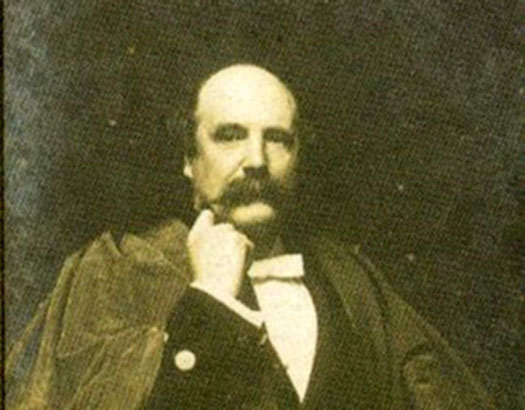
Alexander Williams RHA was the best-known artist in the Graphic Cruisers Club. A taxidermist of international repute, he was also a noted ornithologist, and his interest in maritime subjects was matched by his enthusiasm for landscape. He was one of the first artists to "discover" Achill Island in the west of Ireland, and in time he created a remarkable garden there in a three years project in which he personally worked shoulder-to-shoulder with the build team.
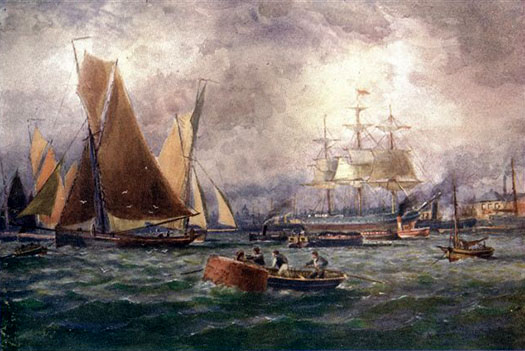
A classic Alexander Williams portrayal of the trawlers of Ringsend with other shipping in the Liffey. Thanks to research by Cormac Lowth, we are now aware of how the style of the Ringsend sailing trawlers came about through links, between 1818 and the 1914 outbreak of Great War, with the pioneering fishing port of Brixham in Devon, which was the most technologically advanced fishing port in Europe in the mid 1800s. Courtesy Cormac Lowth
They were larger than life, every last one of them, and Prescott and Williams in particular were renaissance men who could turn their hand to any number of creative projects at a time when life around Dublin was fairly buzzing for those with the energy and interest to enjoy it.
And there were links to other aspects of Dublin waterfront life which have a further resonance. Back in January, I'd to give one of the supper talks at the National YC in Dun Laoghaire, and on this occasion the topic was John B Kearney (1879-1967), the Ringsend-born yacht designer and boatbuilder who was the club's Rear Commodore for the last 21 years of his life.
You need some sort of special little link to bring these talks to life, but fortunately I remembered that there's a fine big Alexander Williams painting of sailing trawlers at Ringsend in the NYC's dining room. I didn't know its date as we headed round the bay on the night of the talk, but we struck gold. It was dated 1890.

The Brixham style in Ringsend was best exemplified by the largest trawler built in the Dublin port, the St Patrick (right) of 53 tons built in 1887 in the Murphy family's boatyard beside the mouth of the River Dodder. The Murphy family also owned and operated the St Patrick in her fishing, and when John Kearney built his renowned yachts, the earliest (and best) of them were built in a corner of Murphy's Boatyard - the Ainmara in 1912, the Mavis in 1925, and the Sonia in 1929. Photo courtesy Cormac Lowth
Williams was so fond of the Ringsend scene that he lived there for a while in Thorncastle Street where John B Kearney was born, and of course the painter subsequently sailed regularly from the old port in the Iris, and would have over-nighted at Sandefjord too. He is in fact the definitive Ringsend maritime artist, and the picture in the NYC expresses this. And as it includes some of the Ringsend waterfront, we could say that it also includes John B Kearney, for in 1890 the precocious eleven-year-old Ringsend schoolboy was in the boatyards as much as possible, as he had already stated in his quietly stubborn way that his ultimate ambition was to be a yacht designer.
Not a boatbuilder or a shipwright or a harbour engineer, which is nevertheless what he was until he retired in 1944. But upon his leaving the day job - in which he'd been highly respected - he then devoted all his energies to what he had been doing all his life in his spare time. And with his death aged 88 in 1967, his gravestone in Glasnevin cemetery said it all: John Breslin Kearney (formerly of Dublin Port & Docks Board) Yacht Designer.
And if you wonder how on earth we have come to a consideration of John Kearney's memorial stone in an article which purports to be about the social glues which keep boat partnerships in good order, believe me when you get involved with the boys of the Graphic Cruisers Club you never know where it's all going to end.
We've already discovered that in later life Alexander Williams devoted much energy to his garden in Achill while at the same time continuing to be an active member of the Royal Hibernian Academy in Dublin. As for George Prescott, he too broadened his already extensive interests, and in his eighties he was much into amateur opera production, even being so deeply involved as to paint the stage scenery himself.
Dublin too was expanding, so he accepted that a move eastward was needed if he was going to be able to continue to commune directly with his beloved sea. So he left Sandefjord, and the final decades of his wonderful life were spent at his new home at The Hermitage on Merrion Strand. Needless to say, Alexander Williams provided him with a painting of The Hermitage which captured the then unspoilt nature of a place you'd scarcely recognize today.
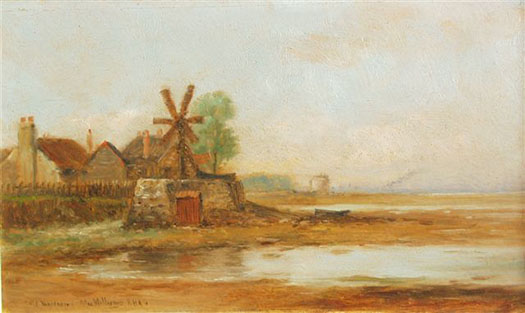
The Hermitage on Merrion Strand, George Prescott's last home as portrayed by Alexander Williams. Courtesy Cormac Lowth




























